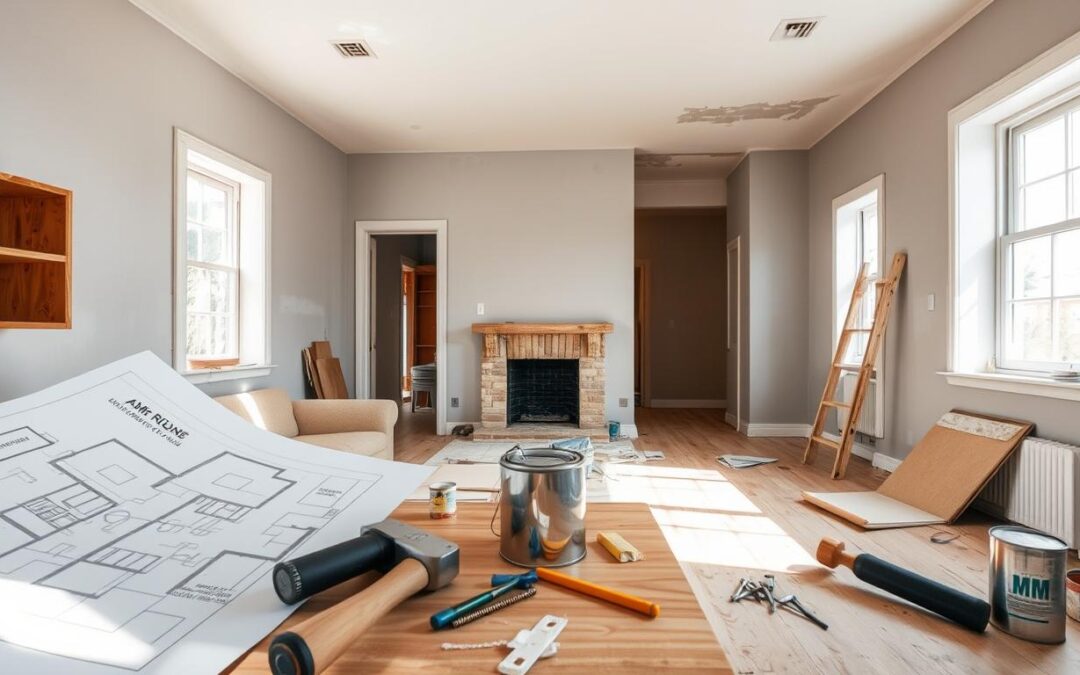Home renovation financing is a way for homeowners to improve their living spaces. It offers financial help for upgrading, repairing, or modernizing homes. Whether it’s a small kitchen update or a big renovation, these loans help make your dream a reality.
Learning about home improvement loans can open doors to improving your property. These tools let homeowners invest in their biggest asset. They can increase your home’s value and make it more comfortable. There are many loan types, each suited for different needs.
Homeowners can use these loans for anything from fixing essential things to making their home look better. Home improvement loans give you the confidence to renovate without using all your savings.
Key Takeaways
- Home improvement loans provide financial support for residential upgrades
- Multiple loan types exist to suit different renovation budgets
- Loans can potentially increase property value
- Financing options range from $1,000 to $100,000
- Annual percentage rates typically vary between 7.5% and 36%
Understanding Home Improvement Loans Basics
Home repair loans and home remodeling loans offer financial help for homeowners. They allow people to fund important upgrades and repairs without using their savings. This is a big help for those looking to improve their homes.
Renovations can be very expensive. It’s important for homeowners to know about home improvement financing. This knowledge helps them make smart choices.
Definition and Purpose
Home improvement loans are made for homeowners to fund their renovation projects. They help with:
- Enhancing property value
- Addressing critical maintenance needs
- Modernizing living spaces
- Improving home functionality
Key Features of Home Improvement Financing
There are two main types of home repair loans:
| Loan Type | Characteristics | Risk Level |
|---|---|---|
| Secured Loans | Requires collateral | Lower interest rates |
| Unsecured Loans | No collateral needed | Higher interest rates |
Who Can Benefit from These Loans
Home remodeling loans are great for many homeowners. They are perfect for:
- First-time homeowners needing initial upgrades
- Individuals planning major renovation projects
- Homeowners seeking to increase property value
- People addressing urgent repair requirements
“Smart financing can transform your home without breaking the bank.” – Real Estate Investment Experts
Knowing about these loans helps homeowners make smart financial choices. It ensures their renovation goals and budget match.
Types of Home Improvement Financing Options
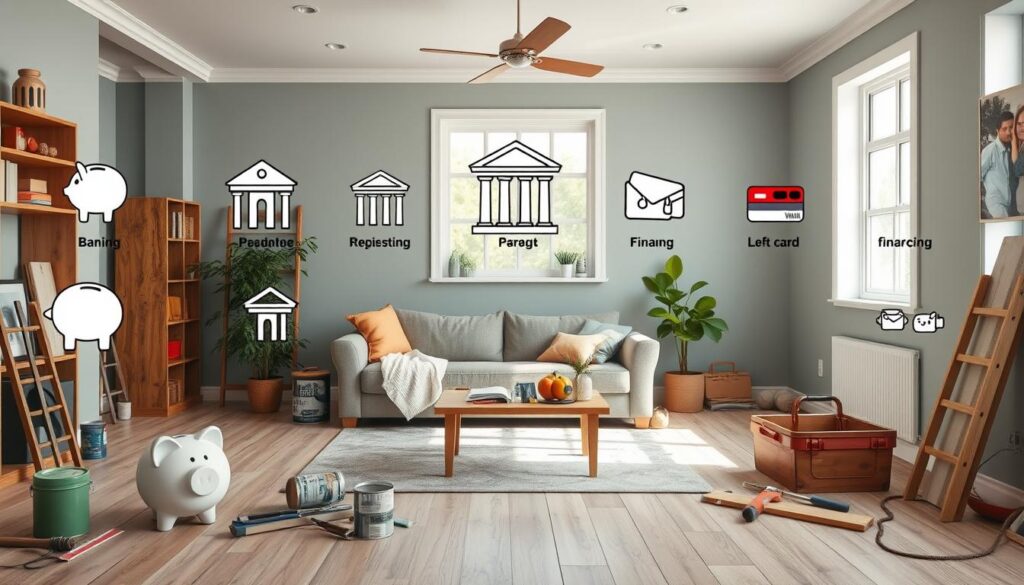
Homeowners have many ways to fund their home upgrades. Knowing the different home upgrade loans can help you pick the best one for your project.
Here are the main financing strategies for home improvements:
- Home Equity Loans: Allows borrowing up to 100% of home equity with terms ranging from 5 to 30 years
- Home Equity Lines of Credit (HELOCs): Flexible credit lines with minimal closing costs
- Personal Home Improvement Loans: Unsecured options with faster funding
- Cash-Out Refinancing: Replacing existing mortgage to access additional funds
- FHA 203(k) Renovation Loans: Government-backed financing for extensive renovations
Choosing the right home equity loans depends on several key factors:
- Total project cost
- Credit score
- Available home equity
- Desired repayment timeline
“Choosing the right financing can make your home improvement dreams a reality without breaking the bank.”
A recent LendingTree survey found that 48.59% of homeowners use home equity loans or HELOCs for home improvements. This shows how popular these financing methods are.
Each financing option has its own benefits. Personal loans offer quick funding, while home equity loans have lower interest rates. FHA 203(k) loans are best for big renovation projects needing at least $5,000 in improvements.
What Is a Home Improvement Loan and How Does It Work
Home improvement loans give homeowners money to make their homes better. They can fix, upgrade, or renovate their properties. Knowing how these loans work helps people decide how to finance their home projects.
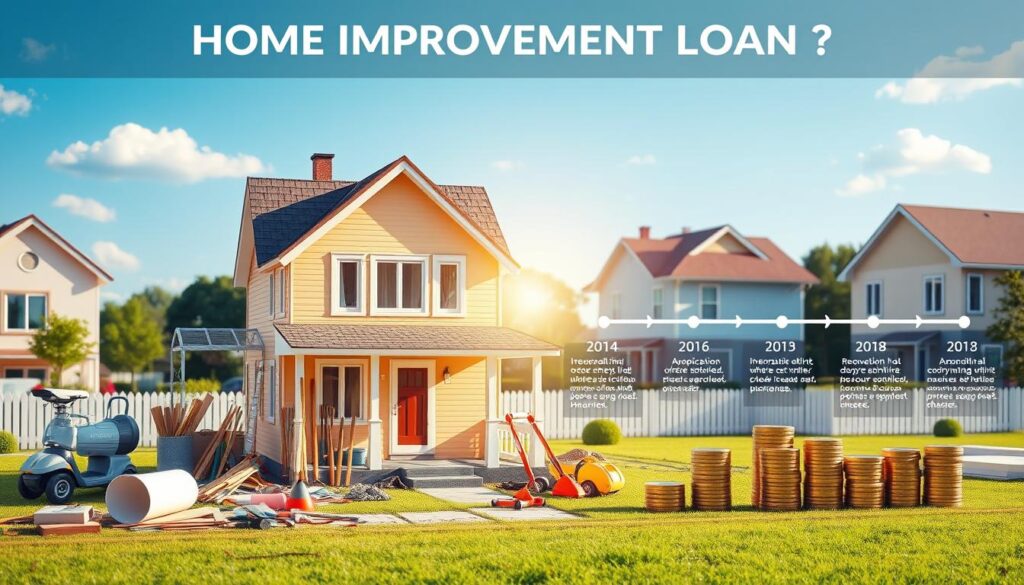
Getting a home improvement loan involves many steps. Homeowners looking to change their homes can find loans that fit their needs.
Loan Application Process
Applying for a home improvement loan has several important steps:
- Check and review your credit score
- Gather necessary financial documentation
- Research and compare lenders
- Look at different loan offers and terms
- Submit a detailed loan application
Approval Requirements
Lenders look at several things when deciding on home construction loans. Important factors include:
- Credit score (usually 620 or higher)
- Debt-to-income ratio
- Steady income proof
- Home equity value
- Details of the renovation
“Understanding loan requirements is key for successful home improvement financing.”
Disbursement Methods
Home improvement loans offer different ways to get funds:
| Disbursement Type | Typical Processing Time | Funding Amount |
|---|---|---|
| Lump Sum Payment | 1-3 business days | $10,000 – $50,000 |
| Staged Payments | 30-60 days | Up to 80% of project cost |
| Draw Period | 5-10 years | Varies by loan type |
Homeowners can get quick funding. Many lenders approve loans the same day and send out funds fast.
Home Equity Loans vs. Personal Loans
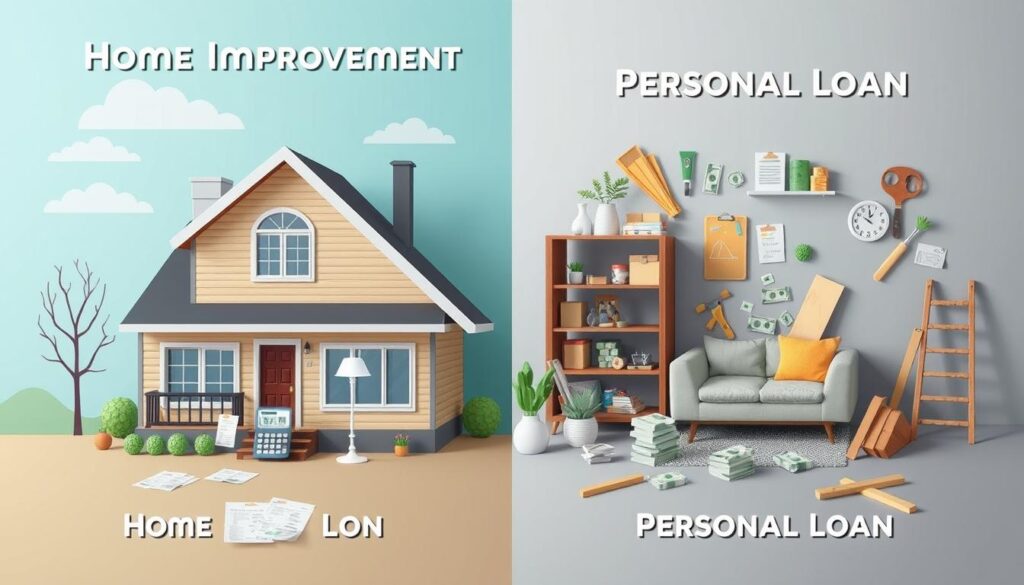
Homeowners have to choose between home equity loans and personal loans for home additions. Each option has its own benefits and challenges.
Home equity loans are great for tapping into your home’s value. They come with interest rates between 7% and 8% APR. You can borrow up to 80% of your home’s value. For example, a $400,000 home could get you around $320,000.
Key Comparison Points
- Interest Rates: Home equity loans have lower rates than personal loans
- Collateral: Your home secures home equity loans
- Loan Amounts: These loans offer bigger borrowing limits
- Repayment Terms: You can repay home equity loans over 30 years
Personal loans are another option for home improvements. They let you borrow from $1,000 to $100,000. But, they often have higher interest rates, sometimes over 20% APR, for those with lower credit scores.
“Choosing between home equity and personal loans depends on your financial situation and risk tolerance.”
Loan Qualification Factors
| Loan Type | Minimum Credit Score | Typical Interest Range | Repayment Term |
|---|---|---|---|
| Home Equity Loans | 620+ | 7-8% APR | 5-30 years |
| Personal Loans | 560+ | 7.5-36% APR | 2-7 years |
Homeowners need to think about their financial situation. They should look at their credit score, how much they want to borrow, and their long-term goals. This helps decide between home equity and personal loans for home improvements.
Understanding Credit Requirements and Eligibility
Getting a loan for home renovations can be tricky. It’s important to know the credit score needed for bathroom remodel loans. Lenders check several things to see if you can get a loan.
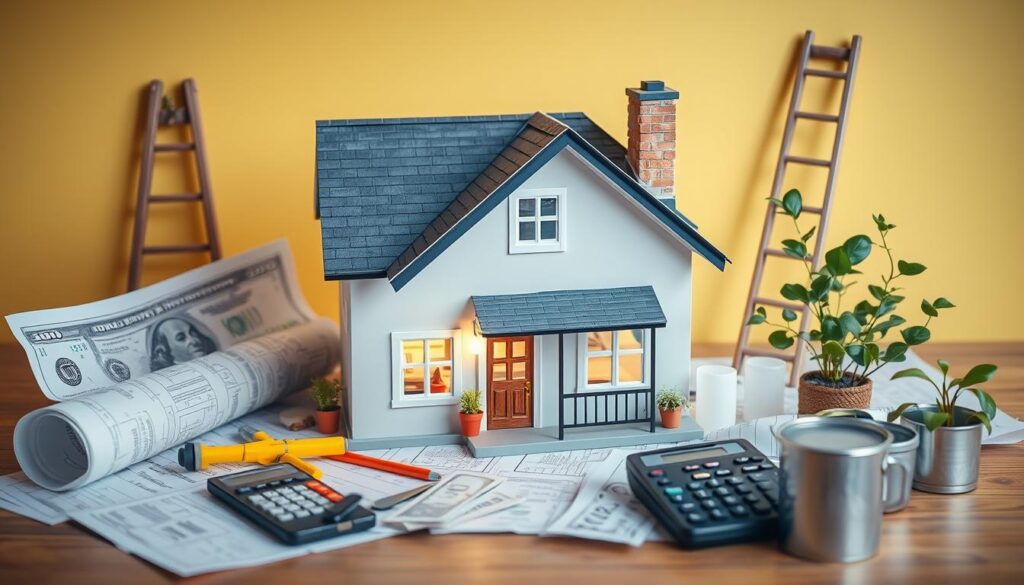
Minimum Credit Score Expectations
Credit scores are key for getting a loan. Most lenders want to see:
- Minimum acceptable score: 620-640
- Good credit score: 670 and above
- Excellent credit score: 740 and higher
“Your credit score is the key that unlocks better loan terms and lower interest rates.”
Income and Debt Considerations
Lenders look at your financial health closely. They check two main things:
- Debt-to-Income (DTI) Ratio: Most lenders prefer a DTI below 43%
- Stable income verification for bathroom remodel loans
Essential Documentation
Having the right documents makes applying for a loan easier. You’ll need:
- Proof of income (W-2, pay stubs)
- Tax returns for the past two years
- Bank statements
- Detailed renovation project plans
Those with high credit scores (740+) get better deals. They can get lower interest rates and bigger loans for renovations.
Interest Rates and APR Explained
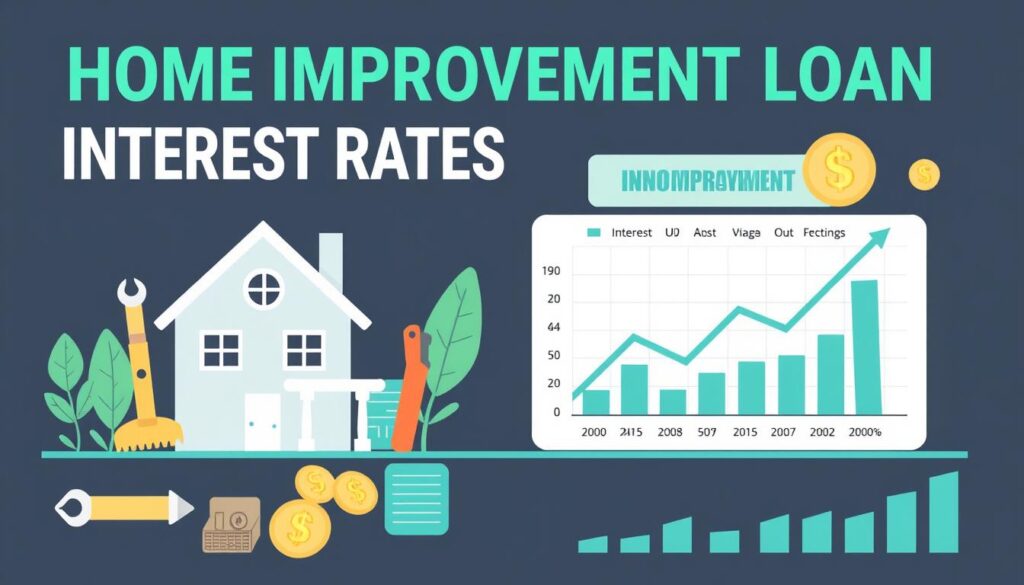
When you look into kitchen remodel loans or home repair loans, it’s key to get the interest rates and Annual Percentage Rate (APR). The APR shows the total cost of borrowing. This includes the interest and any extra fees tied to the loan.
Several things can change loan interest rates:
- Credit score
- Loan term length
- Loan amount
- Current market conditions
For home improvement loans, APRs usually fall between 6.99% to 35.99%. The exact rate depends on a few things:
- Individual credit history
- Income stability
- Debt-to-income ratio
“A lower APR means less total expense over the life of your loan.”
When you’re looking at kitchen remodel loans, fixed-rate options mean your monthly payments stay the same. Home repair loans often have good rates for those who qualify well. The best rates usually need a FICO® score of at least 700.
Here’s how APR works in real life:
- A 5-year $10,000 loan at 9.99% APR means 60 monthly payments of $201.81
- A 3-year $5,000 loan at 6.99% APR results in 36 monthly payments of $152.83
It’s wise to shop around and see how interest rates affect your total costs.
Loan Terms and Repayment Options
Understanding home remodeling loans means knowing about different repayment plans and financial options. Homeowners need to look at various choices to pick the best financing for their projects.
Fixed vs. Variable Rates
There are two main types of interest rates for home improvement loans:
- Fixed Rates: Your monthly payments stay the same for the loan’s life
- Variable Rates: Your interest rate can change with the market
Choosing between fixed and variable rates is a big decision for your future finances.
Repayment Periods
Loans can last from a few years to many, each with its own benefits:
- Short-term loans (1-3 years): You pay more each month, but less in interest
- Medium-term loans (3-5 years): Payments are balanced
- Long-term loans (5-7 years): Payments are lower, but you pay more in interest
Monthly Payment Calculations
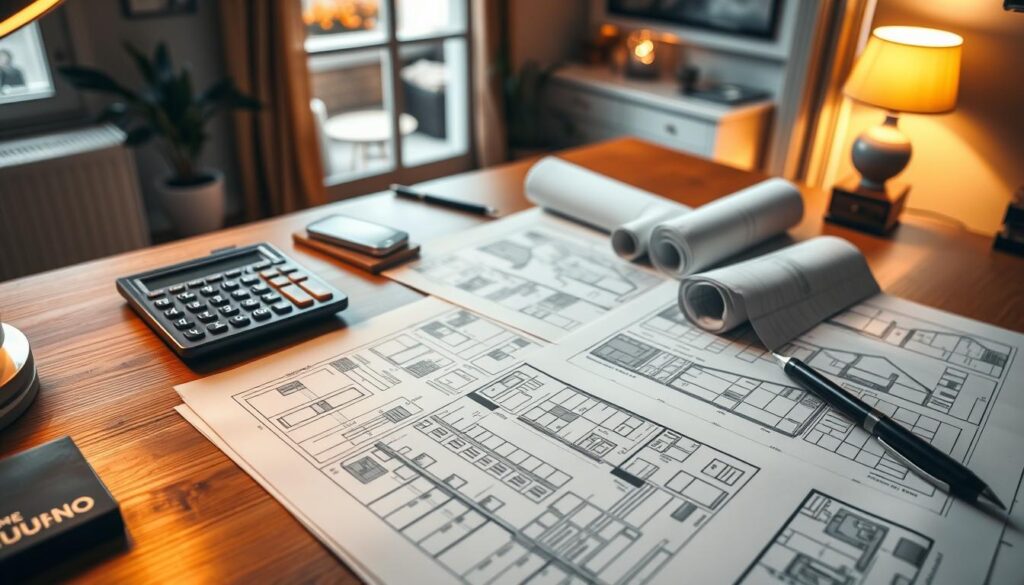
| Factor | Impact on Payment |
|---|---|
| Loan Amount | Directly proportional to monthly payment |
| Interest Rate | Higher rates increase monthly payments |
| Loan Term | Longer terms reduce monthly payment amount |
| Credit Score | Better scores typically result in lower interest rates |
Before choosing a home remodeling loan, borrowers should think about their finances and project costs. Knowing about these repayment options helps homeowners make smart choices for their renovation financing.
Government-Backed Home Improvement Programs
Homeowners looking for financial help for home upgrades have government-backed programs to check out. These programs offer important support for home construction and renovation, mainly for those with low incomes or special needs.
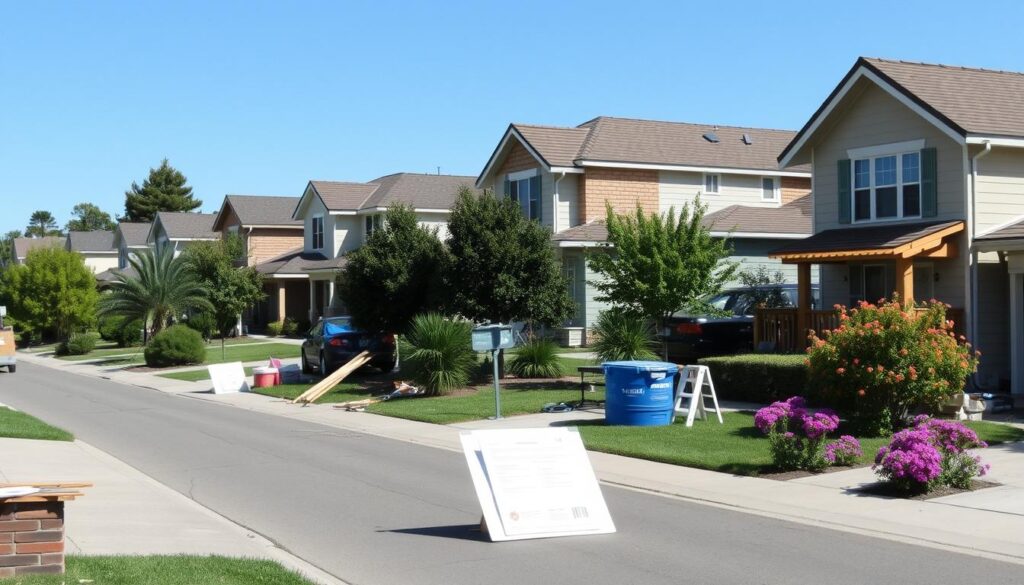
The federal government has many programs to help homeowners improve their homes:
- Section 504 Home Repair Program
- VA Home Adaptation Grants
- Native American Housing Improvement Program
- Home Investment Partnerships Program (HOME)
Veterans get special help through targeted grants. The Specially Adapted Housing (SAH) Grant can give up to $117,014 for home changes. The Special Home Adaptation (SHA) Grant offers about $23,000 for veterans with injuries.
“Government programs can turn home improvement dreams into real possibilities for many Americans.”
Income-based programs like the Home Investment Partnerships Program help low-income families. They have specific rules for who can get help:
| Program | Maximum Grant | Income Requirement |
|---|---|---|
| Native American Housing Program | $60,000 | 150% of DHHS Poverty Guidelines |
| Section 504 Home Repair | $7,500 | 50% of Area Median Income |
| VA SAH Grant | $117,014 | Service-Connected Disability |
Homeowners should look closely at each program’s rules, income limits, and requirements. This will help them see if they qualify for these valuable loans.
Benefits and Drawbacks of Home Improvement Loans
Home improvement loans help homeowners change their homes. Knowing about these loans is key to smart renovation choices.
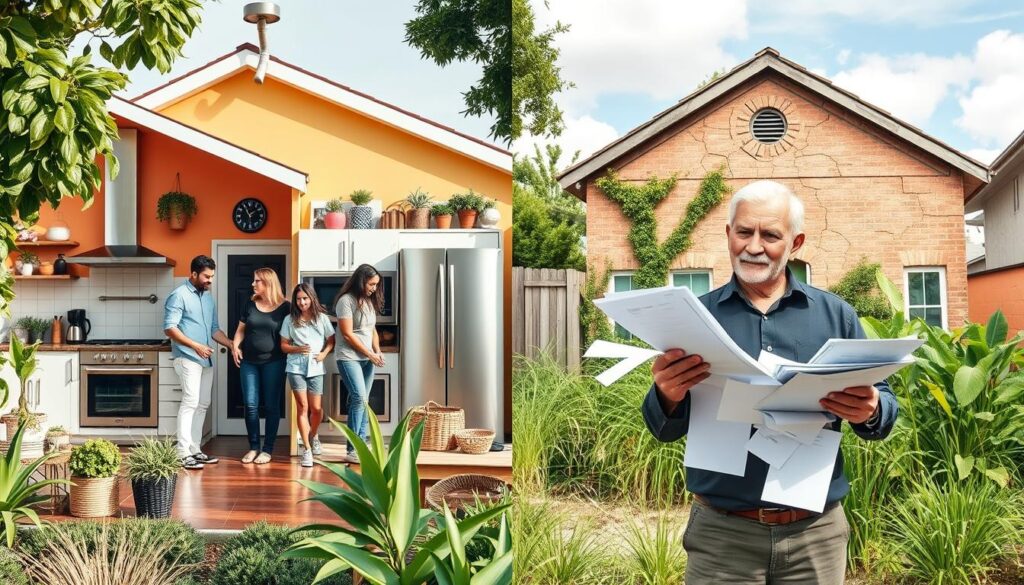
Exploring Renovation Financing Advantages
Home improvement loans have many benefits. They let homeowners:
- Increase their property’s value
- Do big renovations without paying all at once
- Choose from many financing options
- Make their homes more energy-efficient
Potential Financial Risks to Consider
But, there are also risks to think about:
- More debt can be a problem
- Improving too much can be risky
- Secured loans can be a big risk
- Variable interest rates can be tough
| Loan Type | Interest Rate Range | Borrowing Amount |
|---|---|---|
| Personal Loans | 6% – 36% | $1,000 – $50,000 |
| Home Equity Loans | 3% – 8% | Up to 85% of home equity |
| Cash-Out Refinance | 4% – 7% | Varies by home value |
“Understanding the nuanced landscape of home improvement financing empowers homeowners to make strategic renovation decisions.”
Before getting a home improvement loan, think about your finances and goals. Talking to a financial expert can help you make the best choice for your situation.
How to Choose the Right Lender
Finding the right lender for your home renovation is key. Homeowners need to research and compare carefully. This ensures you get the best deal for your bathroom remodel loans.
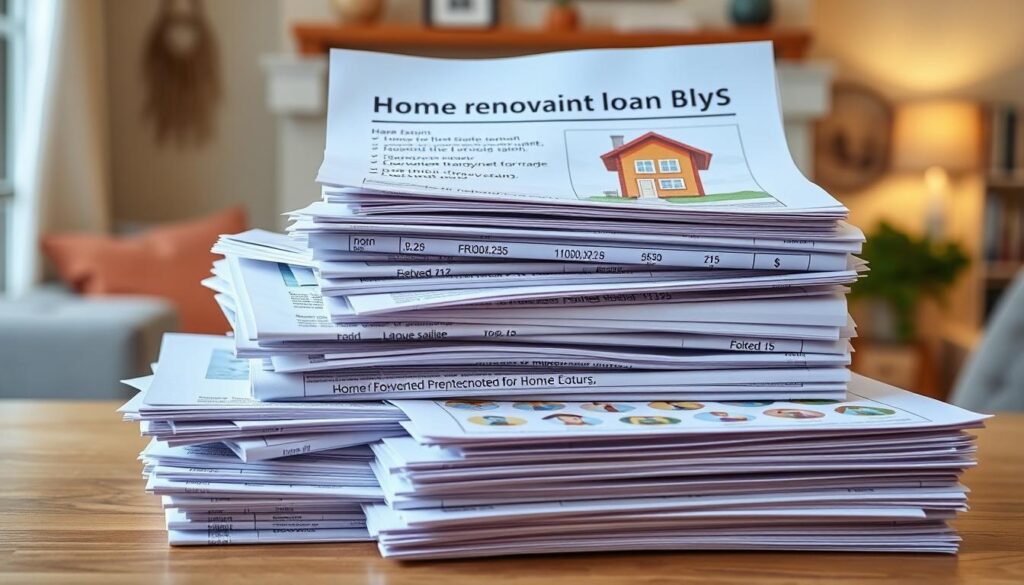
- Interest rates and annual percentage rates (APR)
- Loan term flexibility
- Minimum credit score requirements
- Customer service reputation
- Additional fees and closing costs
“The right lender can make your home improvement dreams become a reality with minimal financial stress.”
Each lender has its own benefits for home renovation financing. Traditional banks, credit unions, and online lenders offer different advantages.
| Lender Type | Pros | Cons |
|---|---|---|
| Traditional Banks | Personal relationship, in-person support | Stricter qualification requirements |
| Credit Unions | Lower interest rates, member benefits | Limited membership |
| Online Lenders | Quick approval, competitive rates | Less personalized service |
To get the best deal, compare quotes from at least three different lenders. Get detailed loan estimates that show all costs and terms. Look closely at:
- Initial interest rates
- Potential rate adjustments
- Prepayment penalties
- Loan origination fees
Remember, your credit score matters a lot. Scores above 640 usually get better terms for home renovation loans.
Tax Implications and Deductions
Understanding taxes on home improvement loans can be tricky. Knowing the tax perks of kitchen remodel loans and home equity loans helps homeowners make smart choices.
Tax-Deductible Home Improvements
The IRS has rules for tax deductions on home improvements. Not every renovation gets a tax break. But, big upgrades can save a lot of money.
- Major renovations that increase home value
- Structural improvements
- Significant home system upgrades
Key Tax Deduction Criteria
Home equity loans for big home upgrades might get tax deductions. The Tax Cuts and Jobs Act of 2017 changed the rules. Now, there are new guidelines for homeowners.
| Loan Type | Tax Deduction Limit | Qualification Criteria |
|---|---|---|
| Home Equity Loans | $750,000 (joint filers) | Must improve primary or secondary residence |
| Married Filing Separately | $375,000 | Interest deductible for qualifying improvements |
Energy Efficiency Credits
Homeowners can get big tax credits for green home upgrades. The Residential Clean Energy Property Credit gives big financial benefits for eco-friendly changes.
“Investing in energy-efficient home improvements can provide both environmental benefits and financial savings through tax credits.”
- Up to 30% tax credit for qualifying energy installations
- Includes solar panels, heat pumps, and efficient heating systems
- Credit available for installations between 2021-2033

Disclaimer: Tax laws are complex and subject to change. Consult a tax professional for personalized advice regarding home improvement loan tax implications.
Alternative Financing Methods

Homeowners looking for funds for home repairs and remodeling have many options. These go beyond traditional loans. Knowing these choices can help you pick the best one for your project.
Credit cards are a fast way to get money for small projects. But, they have high interest rates, from 26% to 36%. This makes them less good for big renovations.
- Cash-out refinancing lets homeowners use their home’s equity
- Personal lines of credit offer flexible borrowing
- Retirement account loans are another funding option
- Peer-to-peer lending offers new ways to finance
Homeowners can also look into government-backed programs like Fannie Mae HomeStyle and FHA 203k loans. These loans for home repairs often have:
- Lower down payments (as low as 3%)
- More flexible credit score rules
- Longer repayment times
*”The right financing method can turn your home improvement dreams into reality”* – Real Estate Financing Expert
For big renovations, construction loans offer a lot of money. These loans can let you borrow over $1 million. They have terms up to 30 years.
Every financing option has its own benefits and risks. Think about your finances, project size, and future plans before choosing.
Conclusion
Knowing what a home improvement loan is is key for homeowners wanting to boost their home’s value and function. Choosing the right loan means looking at loan amounts, interest rates, and your financial health carefully.
Homeowners have many financing options. Personal loans can go up to $40,000, and home equity loans offer even more money. Making smart borrowing choices can lead to big improvements, like new doors and windows, which can add thousands to your home’s value.
Choosing the right loan means doing your homework and knowing your finances. Look at your credit score, debt, and future financial plans. Getting advice from financial experts can help match your renovation dreams with your budget.
Getting a home loan for renovations takes time and effort. It’s important to compare loans, understand risks, and make choices that fit your financial goals. This way, you can improve your home without breaking the bank.
